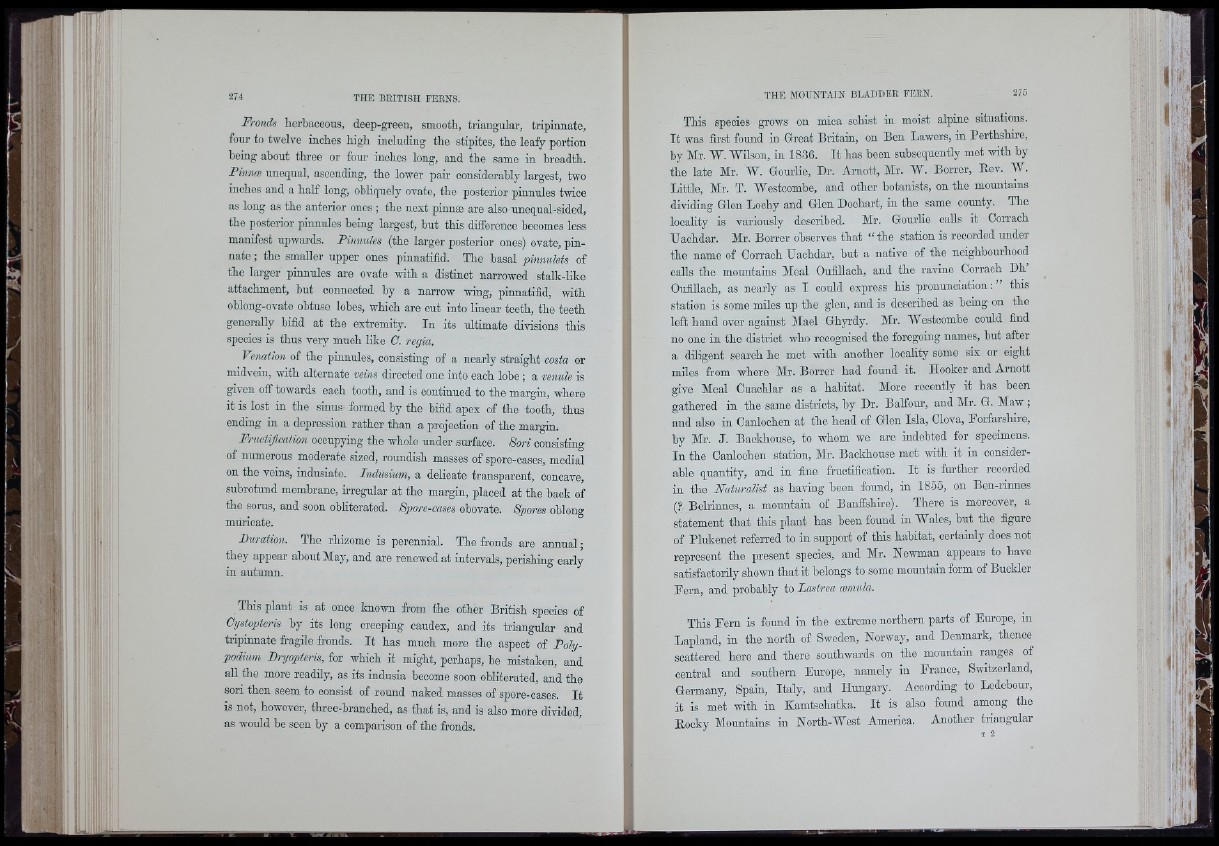
Fronds herbaceous, deep-green, smooth, triangular, tripinnate,
four to twelve inches high including the stipites, the leafy portion
being about three or four inches long, and the same in breadth.
Pinnæ unequal, ascending, the lower pair considerably largest, two
inches and a half long, obliquely ovate, the posterior pinnules twice
as long as the anterior ones ; the next pinnæ are also unequal-sided,
the posterior pinnules being largest, but this difference becomes less
manifest upwards. Pinnules (the larger posterior ones) ovate, pinnate
; the smaller upper ones pinnatifid. The basal pinnulets of
the larger pinnules are ovate with a distinct narrowed stalk-like
attachment, but connected by a narrow wing, pinnatifid, with
ohlong-ovate obtuse lobes, which are cut into linear teeth, the teeth
generaUy bifid at the extremity. In its ultimate divisions this
species is thus very much like G. regia.
Venation of the pinnules, consisting of a nearly straight costa or
midvein, with alternate veins directed one into each lobe ; a venule is
given off towards each tooth, and is continued to the margin, where
it is lost in the sinus formed by the bilid apex of the tooth, thus
ending in a depression rather than a projection of the margin.
Fructification occupying the whole under surface. Sori consisting
of numerous moderate sized, roundish masses of spore-cases, medial
on the veins, indusiate. Indusium, a dehoate transparent, concave,
suhrotund membrane, irregular at the margin, placed at the back of
the sorus, and soon obhterated. Spore-cases obovate. Spores oblong
muricate.
Buration. The rhizome is perennial. The fronds are annual ;
they appear about May, and are renewed at intervals, perishing early
in autumn.
This plant is at once known from the other British species of
Cystopteris by its long creeping caudex, and its triangular and
tripinnate fragile fronds. It has much more the aspect of Polypodium
Bryopteris, for which it might, perhaps, be mistaken, and
aU the more readily, as its indusia become soon obliterated, and the
sori then seem to consist of round naked masses of spore-cases. It
is not, however, three-branohed, as that is, and is also more divided,
as would be seen by a comparison of the fronds.
This species grows on mica schist in moist alpine situations.
It was first found in Great Britain, on Ben Lawers, in Perthshire,
by Mr. W. Wilson, in 1836. It has been subsequently met with by
the late Mr. W. Gourlie, Dr. Arnott, Mr. W. Borrer, Eev. W.
Little, Mr. T. Westcombe, and other botanists, on the mountains
dividing Glen Lochy and Glen Doohart, in the same county. The
locality is variously described. Mr. Gourlie calls it Corrach
Uaohdar. Mr. Borrer observes that “ the station is recorded under
the name of Corrach Uaohdar, but a native of the neighbourhood
calls the mountains Meal Oufillaoh, and the ravine Corrach Dh
Oufillaoh, as nearly as I could express his pronunciation: this
station is some miles up tho glen, and is described as being on the
left hand over against Mael Ghyrdy. Mr. Westcombe could find
no one in the district who recognised the foregoing names, but after
a diligent search he met with another locality some six or eight
miles from where Mr. Borrer had found it. Hooker and Arnott
give Meal Cuachlar as a habitat. More recently it has been
gathered in the same districts, by Dr. Balfour, and Mr. G. Maw ;
and also in Canloohen at the head of Glen Isla, Clova, Forfarshire,
by Mr. J. Backhouse, to whom we are indebted for specimens.
In the Canloohen station, Mr. Backhouse met with it in considerable
quantity, and in fine fructification. It is further recorded
in the Naturalist as having been found, in 1855, on Ben-rmnes
(? Bolrinnes, a mountain of Banffshire). There is moreover, a
statement that this plant has been found in Wales, bnt the figure
of Plukenet referred to in support of this habitat, certainly does not
represent the present species, and Mr. Newman appears to have
satisfactorily shown that it belongs to some mountain form of Buckler
Fern, and probably to Lastrea csmula.
This Fern is found in the extreme northern parts of Europe, in
Lapland, in the north of Sweden, Norway, and Denmark, thenoe
scattered here and there southwards on the mountain ranges of
central and southern Europe, namely in Eranoe, Switzerland,
Germany, Spain, Italy, and Hungary. According to Ledebour,
it is met with in Kamtschatka. It is also found among the
Eooky Mountains in North-West America. Another triangular
II
I' A
A
I ' hî*
ì• 'iiF
;|. : I j
:’i
7 1 .L
1 "I
rri/-r'
Y' À
' i f c l
IY /
till
lì!